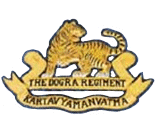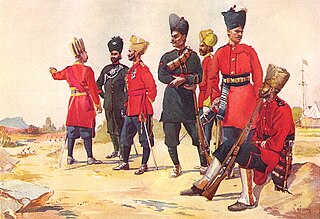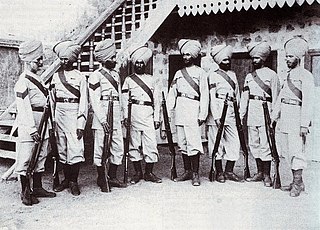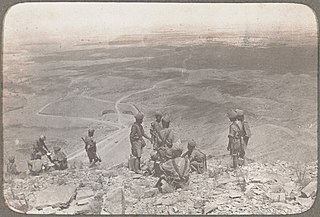Related Research Articles

The Dogra Regiment is an infantry regiment of the Indian Army. The regiment traces its roots directly from the 17th Dogra Regiment of the British Indian Army. When transferred to the Indian Army like its sister regiments, the numeral prefix was removed. Units of the Dogra Regiment have fought in all conflicts that independent India has been engaged in, making it one of the most prestigious and most decorated regiments of the Indian Army.
The 39th Garhwal Rifles was an infantry regiment of the British Indian Army.
The 41st Dogras were an infantry regiment of the British Indian Army. They could trace their origins to 1900, when they were raised as the 41st (Dogra) Bengal Infantry.

The 112th Infantry were an infantry regiment of the East India Company's Bombay Army and lather the British Indian Army. The regiment traces their origins to 1796, when they were raised as the 2nd Battalion, 6th Regiment of Bombay Native Infantry.

The 113th Infantry were an infantry regiment of the British Indian Army. The regiment traces their origins to 1800, when they were raised as the 1st Battalion, 7th Regiment of Bombay Native Infantry.

The 120th Rajputana Infantry were an infantry regiment of the British Indian Army. The regiment traces their origins to 1817, when they were raised as the 2nd Battalion, 10th Regiment of Bombay Native Infantry.
The 4th Prince Albert Victor's Rajputs was an infantry battalion of the British Indian Army. They could trace their origins to 1798, when they were the 2nd Battalion, 16th Bengal Native Infantry. Over the years they became known by a number of different titles. The 33rd Bengal Native Infantry 1824–1861, the 4th Bengal Regiment of Bengal Native Infantry 1861–1890, the 4th Bengal Infantry 1890–1897, the 4th Rajput Regiment 1897–1901 and finally after the Kitchener reforms of the Indian Army the 4th Rajputs. To honour the visit of the Prince and Princess of Wales to India they took part in the Rawalpindi Parade 1905. They took part in the First Anglo-Sikh War, the Second Anglo-Afghan War, the Third Anglo-Burmese War and World War I. After World War I the Indian government reformed the army again moving from single battalion regiments to large multi battalion regiments, the 4th Prince Albert Victor's Rajputs became the 2nd Battalion, 7th Rajput Regiment. After India gained independence they were one of the regiments allocated to the Indian Army.

The 11th Rajputs was an infantry regiment of the Bengal Army and later of the British Indian Army. They could trace their origins to 1825, when they were the 2nd Extra Battalion, Bengal Native Infantry. In 1828 they were renamed the 70th Bengal Native Infantry and a number of changes in name followed the 11th Bengal Native Infantry 1861–1885, the 11th Bengal Infantry 1885–1897, the 11th (Rajput) Bengal Infantry 1897–1901, the 11th Rajput Infantry 1901–1903. Finally in 1903, after the Kitchener reforms of the Indian Army the 11th Rajputs.
The 16th Rajputs was an infantry regiment of the Bengal Army and later of the united British Indian Army. It can trace its origins to 1857, during the Indian Mutiny when it was formed from men of the 13th, 48th and 71st Bengal Native Infantry regiments that remained loyal to the British. Named The Lucknow Regiment they were responsible for guarding the Bailey Gate in the Lucknow Residency. Over the years they were known by a number of different titles the 16th Bengal Native Infantry in 1861, the 16th Bengal Native Infantry 1864, the 16th Bengal Infantry 1885, the 16th Rajput Bengal Infantry 1897, the 16th Rajput Infantry 1901 and finally after the Kitchener reforms of the Indian Army the 16th Rajputs.
The 14th King George's Own Ferozepore Sikhs was a regiment of the British Indian Army; they can trace their origins to the Regiment of Ferozepore formed in 1846. The regiment had a number of different titles over the following years: the 14th Bengal Native Infantry 1861–1864, the 14th Regiment of Bengal Native Infantry 1864–1885, the 14th Regiment of Bengal Native Infantry 1885–1901, the 14th (Ferozepore) Sikh Infantry 1901–1903 and finally, after the Kitchener reforms of the Indian Army in 1903, the 14th Ferozepore Sikhs.
The 10th Jats were an infantry regiment of the British Indian Army. They could trace their origins to 1823, when they were known as the 1st Battalion, 33rd Bengal Native Infantry. Over the years they became known by a number of different titles. The 65th Bengal Native Infantry 1824–1861, the 10th Bengal Native Infantry 1861–1885, the 10th Bengal Infantry 1885–1897, the 10th Jat Bengal Infantry 1897–1901, the 10th Jat Infantry 1901–1903 and finally in 1903 the 10th Jats.
The 36th Sikhs was an infantry regiment in the British Indian Army. They could trace their origins to 1887, when they were the 36th (Sikh) Bengal Infantry. Composed of Jatsikhs, it was created by Colonel Jim Cooke and Captain H. R. Holmes. They had one other change in title in 1901, when they became the 36th Sikh Infantry. They finally became the 36th Sikhs in 1903, after the Kitchener reforms of the Indian Army. During this time they fought an action in 1897, in defence of the Samana Ridge against a huge army of Pathans in the Battle of Saragarhi. To honour the visit of the Prince and Princess of Wales to India they took part in the Rawalpindi Parade 1905. During World War I they were stationed as part of the Garrison of Tianjin in China and took part in the Siege of Tsingtao.

The 51st Sikhs was an infantry regiment of the British Indian Army. It was raised in 1846 as the 1st Regiment of Infantry The Frontier Brigade. It was designated as the 51st Sikhs in 1903 and became 1st Battalion 12th Frontier Force Regiment in 1922. In 1947, it was allocated to the Pakistan Army, where it continues to exist as 3 Battalion The Frontier Force Regiment.

The 34th Royal Sikh Pioneers was an infantry regiment of the British Indian Army. They could trace their origins to 1857, when they were raised as the Punjab Sappers. The regiment recruited exclusively from the Mazhabi Sikh community of Punjab province. Despite being "pioneers" by name, the regiment functioned as a Sikh infantry regiment specially trained as assault pioneers.

The 35th Sikhs were an infantry regiment of the British Indian Army. They could trace their origins to 1887, when they were raised as the 35th (Sikh) Bengal Infantry.

The 38th Dogras were an infantry regiment of the British Indian Army. They could trace their origins to 1858, when they were raised as an irregular unit named the Agra Levy. In 1864 the regiment was incorporated into the regular line infantry of the Bengal Army, under the title of the 38th (Agra) Regiment Bengal Native Infantry.

The 61st Pioneers were an infantry regiment of the British Indian Army. They could trace their origins to 1758, when they were raised as the 1st Battalion Coast Sepoys.
The 102nd Prince of Wales's Own Grenadiers was an infantry regiment of the British Indian Army. It could trace its origins to 1796, when it was raised as the 13th Battalion, Bombay Native Infantry.

The 114th Mahrattas were an infantry regiment of the British Indian Army. The regiment traces their origins to 1800, when they were raised as the 2nd Battalion, 7th Regiment of Bombay Native Infantry.

The 122nd Rajputana Infantry were an infantry regiment of the British Indian Army. The regiment traces their origins to 1818, when they were raised as the 2nd Battalion, 11th Regiment of Bombay Native Infantry.
References
- ↑ http://www.britishempire.co.uk/forces/armyunits/indianinfantry/37thdogras.htm
- ↑ British Official History of the Great War, Mesopotamia Campaign Vol. 4
- ↑ Sumner p.15